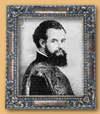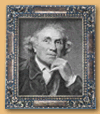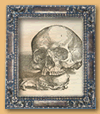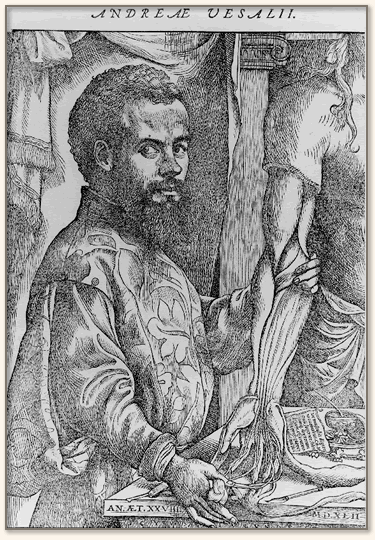
.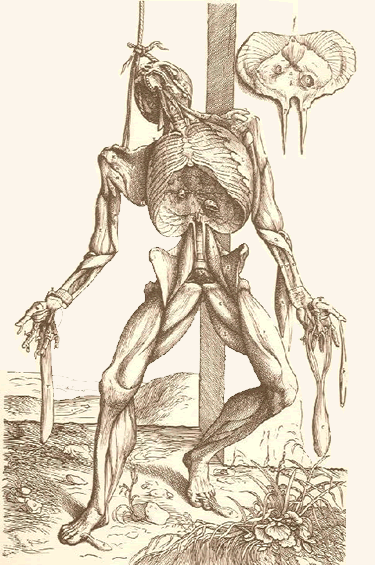
Plate from De fabrica
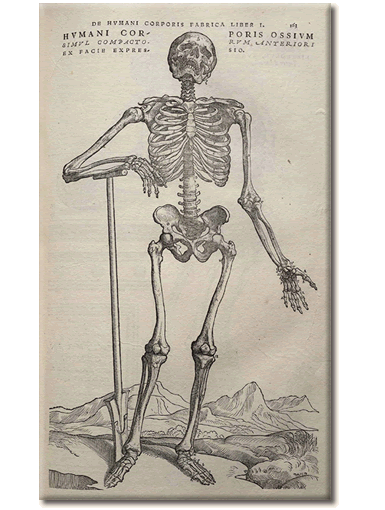

Andreas Vesalius’s contributions to anatomy and physiology are so profound that critics believe “few disciplines are more surely based on the work of one man than is Anatomy on Vesalius.”1 Born in Brussels and trained in anatomy at the University of Padua (where he would return to teach), Vesalius became the leading figure in the renewed practice of human dissection. He produced two seminal texts, Tabulae sex (Six Plates, 1538) and De humani corporis fabrica (The Fabric of the Human Body, 1543). De humani signaled a revolution, in that its plates offered the most accurate depictions of a human’s internal organs to date. The power of the images came, in part, from using woodcuts, a process that allowed the greatest accuracy in reproduction.2 The greatest power, however, came from Vesalius’s commitment to witness firsthand actual human organs, a practice that had been prohibited in much of Europe prior to 1482. Vesalius foregrounded the importance of “ocular evidence,” and his publications represent the first original monograph in any discipline to be based so closely on empirical observation.3 As a result, his major work, De humani, revealed the most accurate account of human anatomy ever published and established the standard methodology by which dissection and anatomy would be practiced until the modern era.4 Coincidentally, Vesalius’ Fabrica was printed the same year as Nicholas Copernicus’ On the Revolutions of the Celestial Spheres, and the two produced a fundamental shift in mankind’s perception of subjectivity . Anticipating the Enlightenment spirit of critique, Vesalius openly repudiated the anatomical teachings of Galen, whose work had been the gold standard for more than a millenium. While Galen had based his anatomical teaching on observations of other mammals, Vesalius’s ability to accumulate ocular evidence made Galen’s work seem truly antiquated and based on patent falsities. Vesalius’s turn against Galen was likely liberating and vexed, for Vesalius had begun his work as a Galenic anatomist; his famous Tabulae sex were illustrations of the Galenic Anatomical Institutions.5 Although Vesalius maintained a connection between theology and anatomy, he also transformed the Galenic theory of determinism. Vesalius always considered the body as an integrated whole, but in order to understand its teleology, he claimed the anatomist had to understand the body as “a fabric, a piece of workmanship by the Great Craftsman,” that is to say, the human body is a work of art executed by a divine artisan.6 In both Galen’s and Vesalius’s teleology, the purpose of the body was to enable the fulfillment of the soul, while for Vesalius, specifically, the body was a microcosm that demonstrates God’s divine design, not the subject’s ability to govern it.7 Additionally, Vesalius disrupted the centuries old conventions of public dissection, and his new practices—when performed for the public or disseminated by his audiences—effected changes outside the theater and into the culture at large. As a professor at Padua, Vesalius accrued a cohort of disciples, Vesalians, that continued his work through generation of anatomical practice. His first major student, Falloppio, succeeded him as professor at Padua.8 Falloppio used direct observation of ocular evidence to discover the Fallopian tubes that bear his name, although he did not ascertain their functions. In fact, while the Vesalians made great contributions to the mapping of the body’s interior, they largely advocated Galenic physiology. In turn, Falloppio was succeeded by Giralamo Fabrizio, who also became professor at Padua.9 Fabrizio is famous for identifying the valves in the veins; like Falloppio, he did not know what purpose his discovery served, although his work was foundational for William Harvey. |
![]()
